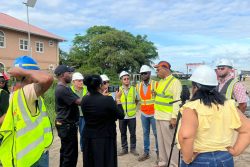A futuristic proposal that would radically transform Guyana’s economy was unveiled yesterday kicking off a three-month consultation process that seeks the input of stakeholders in shaping a Low-Carbon Develop-ment Strategy for the country.

The plan outlines Guyana’s approach to promoting economic development in an environmentally sustainable way. A key part of the strategy involves the deployment of Guyana’s rainforest towards addressing global climate change.
President Bharrat Jagdeo sought to reassure those involved that the Low-Carbon Development Strategy would not see the cessation of economic activities in the forest. “Moving our national economy onto a low-deforestation, low-carbon path does not mean stopping all economic activities in our forest, he told a packed house at the International Conven-tion Centre at Liliendaal. “Mining and forestry will continue but they will have to be done to standards that are compatible with our international obligation and our low-carbon development vision.”
His point was reinforced by Prime Minister Samuel Hinds, who bluntly told miners that they would have to radically transform their mindset and their operations. “There should be no running away from the view that particularly small and medium scale mining has to be rapidly transformed,” he told a consultation session for those in that sector. Following yesterday’s launching of the draft strategy, a general consultation, one for miners and another for those in the forestry sector, were held.
President Jagdeo, in unveiling the document, recalled his offer of placing almost all of the country’s rainforest under long-term protection and said that initial technical work to facilitate consultations with members of society, has now been completed. He said Guyana is at a key point in national development and there is a need for development options to be considered such as opening up new lands for agriculture and expanding into new economic sectors. He stated that Guyana’s pristine forest is the country’s most valuable asset and it would be economically rational to choose to harness the forest to generate the needed investment.
A key question, he said, is how the country can be developed in a manner that aligns national development needs to the global need to combat climate change. He pointed out that the question is grounded in the fact that too many people around the world continue to see combating climate change and promoting national development as conflicting objectives.
Hurdles

The President acknowledged the hurdles in implementing a Reduced Emis-sions from Deforestation and Degradation (REDD) scheme, which basically involves a rainforest country, such as Guyana, being paid not to cut down its rainforest. He said members of the international community focus on the difficulties in implementing such a scheme and are not giving REDD the same solution-oriented focus as other climate mitigation measures. He declared that this is creating a deadlock that the world cannot afford, resulting in rainforest countries being hesitant to commit to the long-term reorientation of their economies because they are unsure of the scale and predictably of forest payments. “The rest of the international community is hesitant to support forest payment at the scale required because the disproportional emphasis on potential problems with REDD make them unsure that solutions exist for deforestation and this also leads them to fear that rainforest country’s governments may misuse the money,” he observed.
He said halting deforestation is possible but it requires a global partnership that respects the reality that solutions to deforestation are far more likely to emerge from within rainforest countries “than from well meaning policy teams working in isolation in the capitals of the developed world.”
Regarding the question as to why Guyana should attempt to assist the world in fighting climate change, the President said that even though the country did not cause the phenomenon, it is a local problem. He pointed to the vulnerabilities of a large segment of the population, who live under sea level. He also noted the floods and drought-like conditions that have been occurring in various parts of the country. “So the evidence is there that addressing climate change needs, need to be transformed from being seen as an environmental issue into a core development issue that we cannot shy away from or ignore.”
President Jagdeo noted too that the forest is of spiritual significance and a source of well-being to indigenous peoples, and this can never be valued in monetary terms. “But even as we acknowledge that ultimately the value of the rainforest is incalculable, we must also face up to another reality; we are part of a global economy that values the timber that rainforests supply and more critically the agricultural produce that can be grown on the land after trees have been cleared,” he said adding that the world economy sees forests as worth more dead than alive. “The only way we can halt deforestation for the long term is by providing productive economic and employment alternatives in rainforest countries and at a scale which outcompetes the current drivers of deforestation,” he commented.
Historic opportunity
The President said that emerging carbon markets provide Guyana with a historic opportunity to use the global economy to save the world’s rainforest by putting a value on them. “However, while this opportunity is welcomed it will only become a reality if both rainforest countries and the rest of the international community act to make it work.” Critical to Guyana, he said, is that the international community needs to address deforestation within the climate agreement which will replace the Kyoto Protocol and this will require proper incorporation of incentives.
Additionally, REDD must be addressed in the new climate agreement at the scale required and any REDD proposal must attract and sustain the support of the people of rainforest nations. He pointed out that had the forest been used for normal economic activity, the Economic Value to the Nation (or EVN), would be equivalent to an annual payment of US$580. He asserted that generating that amount in normal economic activities would have significant negative consequences for the world.
With regard to the Rupununi Savannah, which has been under the spotlight recently, in the light of recent reports of mining concessions being granted in biodiversity-rich areas and proposals for the establishment of large rice farms there, Jagdeo said that they are trying to find a right balance.
As well as protecting biodiversity, appropriate areas in the Rupununi will be open up for jobs and investments in agriculture where Guyana has a competitive advantage, he stated. Jagdeo pointed out that with regard to forest communities, they will decide whether or not, they want their titled land to be a part of the scheme and should they agree, then it is envisaged that a portion of the forest payments for the lands would flow directly to the communities, while the balance would be placed in an Amerindian Development Fund.
This fund would be used for expansion of social services, the provision of low-carbon energy sources and support for new economic activities that do not threaten the forest, among others, the President said.
Compliance
Meantime, at the mining forum, Amrita Thomas, vice-chairman of Region Seven, which is almost entirely covered by forest and is heavily involved in mining said that the effects of changing weather patterns are being felt in the Amerindians villages. The question of exactly how the rainforest will be preserved was a point she raised. “We are the ones who are preserving the forest,” she stated. Thomas said that while they will be doing their part, Amerindians have been engaged in slashing and burning, moving on, leaving the forest to rejuvenate and “that is how we preserve our forest and we hope to continue in that way”.
Another point raised was whether the initiatives in the hinterland would result in more pressure being placed on the coastland as a result of the population remaining in and operating businesses in the coastal strip. A question raised by a miner was whether the scheme would replace traditional revenue sources such as gold-mining. The Prime Minister had stated that small and medium-scale mining will be much more formalized and urged miners to change attitudes and learn rapidly. He noted that currently they are not meeting the existing standards in the industry.
A high level of scrutiny and a high level of compliance will be enforced, Chairman of the National Climate Committee, Shyam Nokta said. He added that the scheme will result in an “intrusive type of monitoring” involving satellite, on the ground and independent monitoring.
Meantime, as the plan moves forward, Jagdeo said, there will be a need to update laws and the ability to enforce them. Following the consultations, the strategy will be tabled for parliamentary discussion.





